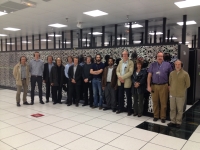 |
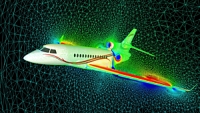 |
| Flow around a business jet aircraft with complex shock-boundary layer interaction, as captured in a section through the CFD unstructured mesh. © Dassault Aviation |
 |
| TGCC du CEA / Technolopole Teratec - Bull Arain - © CEA / P.Stropa |
 |
| Aerodynamic (top) and stealth – in the infra-red (middle) and electromagnetic (bottom) ranges – analyses, as commonly used in the design of the Neuron UCAV demonstrator. © Dassault Aviation – DR (restricted) |
 |
| TGCC du CEA / Technolopole Teratec - ©CEA / P.Stropa |
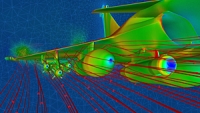 |
| Complex flow structures generated by a Rafale fighter aircraft with external stores, as captured by streamlines through the CFD unstructured mesh. © Dassault Aviation |
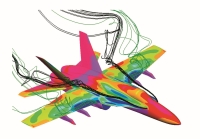 |
| Crédit : © ESI Group |
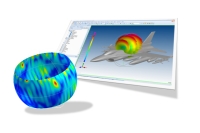 |
| Crédit : © ESI Group |
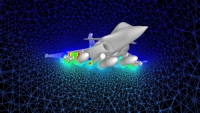 |
| Complex flow structures generated by a Rafale fighter aircraft with external stores, as captured in a section through the CFD unstructured mesh. © Dassault Aviation |
|
> > R&D Projects > Coloc
| |

The COncurrency and LOcality Challenge

Programme : ITEA2 - Call 8
Labellisation : SYSTEMATIC
Project leader :
Statut :
Project Start Date :
Ending date of the project :
Duration :
Partners : BULL ATOS, DASSAULT AVIATION, EFIELD AB, INRIA, SCILAB ENTERPRISES, SWEDISH DEFENCE RESEARCH AGENCY FOI, TERATEC, UNIVERSITE DE VERSAILLES ST-QUENTIN-EN-YVELINES

While the rise of multicore processors and the integration of hardware accelerators greatly increases the compute power of supercomputers, the amount of memory per processor core as well as the network bandwidth remain insufficient. Because of this, an increasing amount of time is spent in communication and data transfers preventing applications from fully exploiting the power of modern highly parallelized and heterogeneous HPC platforms.
To address this issue, the COLOC project intends to adapt both the software infrastructure to better manage the various types of resources and the applications so as to enable them to exploit these resources much more efficiently. This implies a better management of data locality to both reduce access time to data as well as data movements between processors that share a piece of data.
More precisely, the COLOC project focuses its efforts on (i) developing methods and tools enabling to model all resources of a computing platform using a hierarchical topology that describes the characteristics of these resources, (ii) enhancing upper software layers (resource manager such as SLURM; data communication libraries such as MPI; performance analysis tools such as MAQAO) to better manage data placement, thereby maximize application performance, and (iii) validating this approach, using applications from different domains: CFD (Computational Fluid Dynamics), CEM (Computational Electromagnetics), and CSM (Computational Structural Mechanics).
To meet this challenge, the project has assembled several renowned research labs (UVSQ, INRIA, and FOI), a numerical and simulation software editor (Scilab), industrial users (Dassault Aviation for Aeronautics and Efield for aeronautics and automotive), the sole European provider of HPC systems (ATOS-Bull), and the Teratec association to boost and extend dissemination and exploitation of the results.
During the first 18 months of the project, significant achievements have been made:
-
HWLOC, a software package enabling to discover the topology of a whole system has been extended to visualize the level of activity of each component in a hierarchical view, and a library has been developed that enables runtime and upper software layers (MPI, SLURM, …) to exploit this information.
-
A first set of extensions of SLURM (Simple Linux Utility Resources Manager), which is used in more than 50% of the TOP500 systems, has been developed. This set of extensions includes (i) a new version of the Layout Framework that better manages the characteristics of the resources and uses this information to optimize applications or dynamically adapt energy consumption, (ii) the support of new processors (e.g. KNL – Intel Knights Landing), (iii) a first version of a multi-criteria placement algorithm using topology information..
-
A first step in the optimization of two mini-applications: a CFD-FEM (Finite Element Method) use-case with unstructured meshes, and a MLFMM (Multiple Level Fast Multipole Method) use-case in CEM..
-
Several enhancements of the MAQAO performance analysis tool (reduction of the memory footprint, of the instrumentation time, of the execution time, etc.) and a first version of an API enabling to interface MAQAO with other tools such as BullXprof in the bullx scs software suite.
-
The enhancement of Scilab/MPI and SciGPGPU modules and their integration in version 6 of Scilab.
-
An optimized version of the FOISOL solver (developed by FOI) and its API (compatible with MUMPS API from INRIA) which has been installed on the common HPC platform of the project made available by Bull..
-
The integration of the first version of an algorithm using the D&C (Divide & Conquer) method designed by UVSQ, in the CFD software of Dassault-Aviation (AETHER).
-
The parallelization and the acceleration of I/O in the MDMM (Multi-Domain Multi-Method) module by Efield as well as the modernization of the code of other modules.
|

|
| Janvier 2015 -
The ITEA 2 COLOC consortium aims to provide software vendors and simulation service providers with methodologies and tools to develop and hone their applications to gain the most value from expensive and heterogeneous computing resources.
The current trend in the supercomputer industry is focused on providing more and more computational cores but all too often processors are spending an increasing amount of time on communication rather than computation. With data management and storage now a real barrier to allowing applications to fully exploit the power of modern multi/many-core processors, COLOC seeks to design, implement and validate a new approach to break this barrier.
The project will work on disruptive and innovative approaches to manage thread concurrency and I/O locality on large-scale platforms, including memory management, CPU usage, accelerator technology, the network and storage, especially I/O, by taking all of these aspects into account concurrently and in relation to each other in order to optimise the use of applications and high-performance computing resources on all levels. Continuous updating of the state of the art to keep track of major changes in science, technology and industry will result in a public deliverable that extends and develops this state of the art. The project has assembled the most renowned European supercomputing centres and HPC research, dynamic HPC software tool editors, a range of HPC users to validate the proposed technology in real applications and Europe’s only HPC provider.
The major expected outcomes are new algorithms and tools that will be developed to enhance existing resource managers and runtime systems, with a special focus on efficient mapping of data to processes or vice versa. The project will advance a set of technologies ranging from programming models to data localisation optimisation using extended analysis tools on the whole cluster topology.
Initial expected impacts include the reduction of simulation time and the cost of developing HPC applications while European software tool editors for HPC application programming and the European HPC ecosystem are expected to strengthen their position. Consortium partners will gain a competitive edge, such as Bull gaining a stronger position as a hardware provider and as a provider of complete HPC platform solutions and Efield as an HPC workbench with state-of-the-art tools and hardware while the development of unique automatic optimisation capabilities will help RECOM stave off US-based competitors and DA maintain its edge in the aeronautics industry. |
 |
|
| |
|
|
|
|










